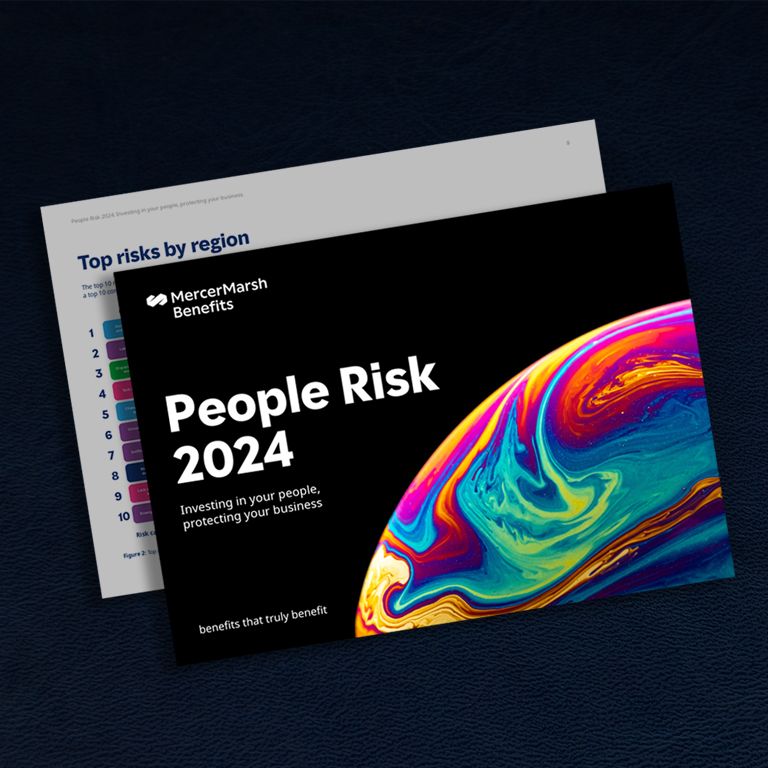By, Alison Byrne and Dr. Ariel Almazan ,
13/07/2022 · 6 min read
Health and safety is a major people-related threat facing organizations, according to risk managers and HR professionals in the People Risk Report 2022. In addition, our Global Talent Trends research showed that 36% of executives have seen measurable returns from their investment in health and well-being[1]. Business leaders are now more aware of the business implications of failing to create a culture of health in the workplace.
This is not surprising—the spread of COVID-19 clearly demonstrated that a firm stands and falls on the well-being of its people. Three years of a pandemic have forced organizations to think carefully about health and safety, with many implementing new programs and initiatives designed to protect the workforce and keep businesses running. It’s now time to take a step back, reflect and reset these programs to incorporate learnings. We’ve been inspired by benefit managers across multiple industries who are re-setting benefits by relevance, incorporating advancements in:
However, the People Risk Report 2022 suggests that businesses are perhaps becoming complacent when it comes to managing and mitigating future health and safety risks. We found that concerns such as mental well-being and workforce exhaustion ranked low when it comes to risk rating scores (likelihood of the risk occurring over a three-year horizon multiplied by the severity, according to HR and risk managers). Yet, the mental health crisis brought on by the pandemic is well-documented and those organizations with poor mental well-being support may find that valued employees prefer the caring attitude promoted by competitors.
The critical importance that employer-sponsored group life, disability, and medical schemes play in people’s lives should not be underestimated. Important health issues are not going away. Employers can play a critical role in helping to meet UN Sustainability Goal #3: Ensure healthy lives and promote well-being for all at all ages[3]. This includes a goal to achieve universal health coverage, including financial risk protection, access to quality essential healthcare services, and access to safe, effective, quality, and affordable essential medicines and vaccines for all.
HR and risk managers respectively ranked mental health 18th and 21st out of 25 risks and workforce exhaustion 22nd out of 25. This is quite stunning considering that these are such pervasive issues, and it seems at odds with intersecting risks that did make it into the top 10, including catastrophic personal life events, changing nature of work and the environment.
We are concerned that mental health is being viewed as “last year’s problem” and that employers feel they have “checked the box” by adding an EAP or running an anti-stigma campaign. The global need for mental healthcare remains a challenge worldwide. The prevalence of mental disorders is rising globally and places a burden on society that needs to be addressed as the issue continues to grow, work continues to intensify, cultures lack inclusiveness and access to necessary mental health support is poor.
Recent crises such as pandemic, violent conflicts, natural disasters, and climate events have highlighted the importance of having a range of mental health supports in place during moments that matter. Some geographies (for example, the UK) are introducing legislation to better prepare for terrorist attacks, including the support needed following an attack.
Broader workforce health needs to be a partnership between the employer and employee. In addition to providing valued support, employers must consider well-being when they design jobs and set working conditions.
If health and safety risks are not managed, they have the potential to lead to misconduct, safety accidents, and other problems; when successfully managed, however, mitigations can support ESG goals, diversity, equity, and inclusion, as well as enable a thriving, energized workforce capable of the creative processes needed for business success.
Rigorous management of health and safety risks has helped many organizations continue business operations during the pandemic. While companies should stay vigilant in monitoring health and safety indicators including absenteeism, workforce stress levels, rotation, accident rates, temporary hiring, work conflicts, premium costs, and litigation activity, we also urge them to consider the broader impact that workforce health programs and healthy cultures have on productivity, engagement, and quality of life. As executives are incented by factors other than financial performance, the social roles that benefit programs and support for employees along their unique health journeys can play in advancing healthy societies should not be underestimated.
[1] Mercer. Global Talent Trends Study, 2022. Available at www.mercer.com/our-thinking/career/global-talent-hr-trends.html.
[2] World Health Organization.2022. COVID-19 pandemic triggers 25% increase in prevalence of anxiety and depression worldwide. Available at https://www.who.int/news/item/02-03-2022-covid-19-pandemic-triggers-25-increase-in-prevalence-of-anxiety-and-depression-worldwide
[3] United Nations. (2020, September 19). Take Action for the Sustainable Development Goals. United Nations Sustainable Development. Available at https://www.un.org/sustainabledevelopment/sustainable-development-goals/
[4] International Organization for Standardization. (2021, June). ISO 45003:2021 Occupational health and safety management — Psychological health and safety at work — Guidelines for managing psychosocial risks. Available at https://www.iso.org/standard/64283.html

UK Workplace Health Consulting Team Leader, MMB

Wellness, Health & Claims Director, MMB

Report
22/04/2024